Technical writing style guides are designed to provide the necessary formatting styles to help technical writers create engaging and consistent content for readers. However, technical writing is quite different from regular freelance writing. The purpose is to break down a complex and technical topic into easily understandable content to help the reader know how to use a product or service.
In this article, we’ll share some of the best technical writing guidelines that various organizations adopt. Think of this as a set of standards to help you write consistently. This will include different examples to help technical writers determine the best option for their needs.
What is a Technical Writer Style Guide?
As a technical writer, you must write in an unbiased and straightforward tone. Therefore, technical writing style guides serve as rules that define the specific structure, format, and tone used in your technical document. These also cover punctuation, references, terminologies, abbreviations, spelling, and grammar. While an organization could adopt a specific style guide, there are broad examples of technical writer style guides that are acceptable across various industries.
These style guides are also specific on the types of text to avoid and the best way to include images in your technical document. One of the most significant benefits of adopting technical writing guidelines is that these templates ultimately help you write more clearly. This is helpful for both the readers and writers who work on similar content styles daily.
Using the style guide, you can define the style to adopt in various forms of technical communication, including procedural writing and user manuals. Overall, this is a fantastic way to present your written content with more professionalism while complying with the ethical and legal requirements of being a technical writer.
6 Technical Writing Style Guide Examples
Various companies have adopted style guides that are useful internally among employees and externally for other brands that would love to adopt this for their technical writers. These technical writing style guide examples give you a direct insight into the best formatting styles for various technical documents.
-
Google developer style guide
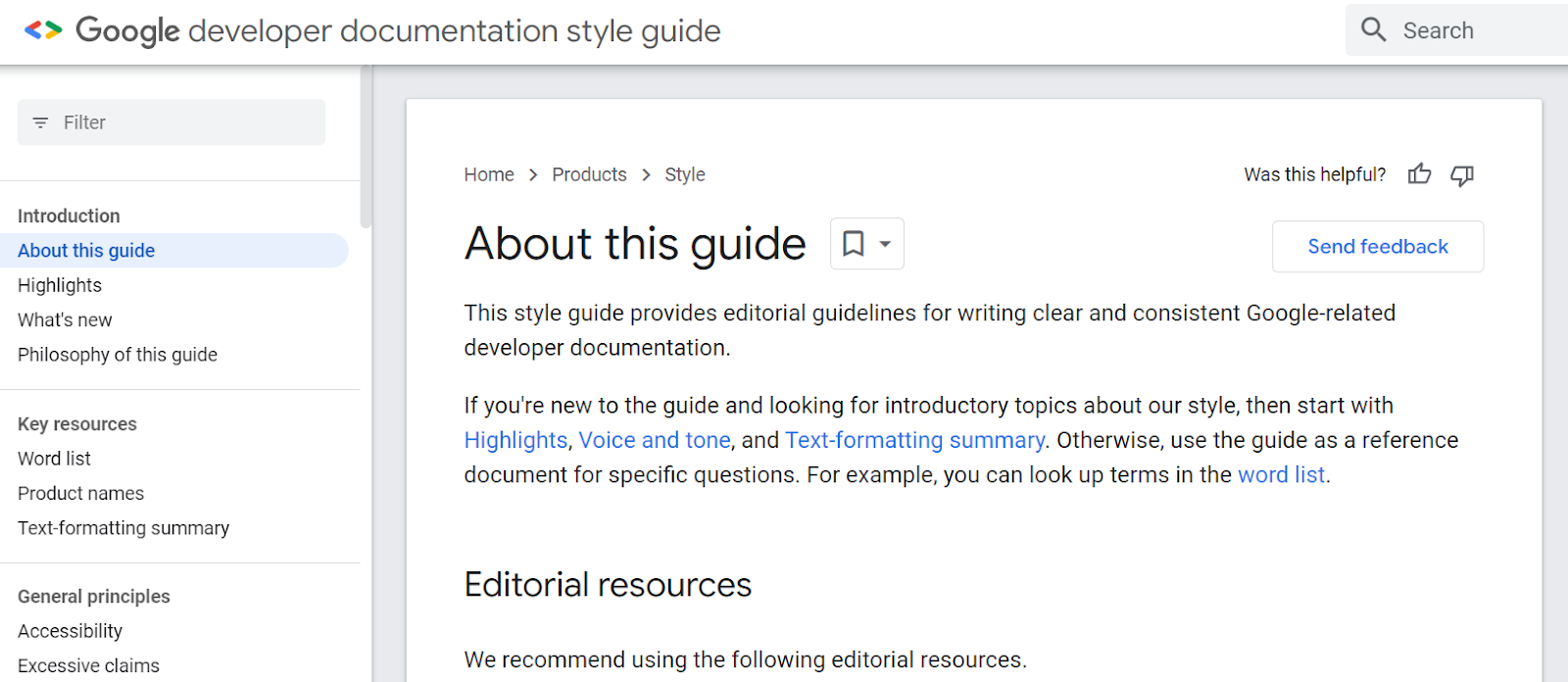
Image Source: Google developer style guide
The Google developer style guide provides technical writing guidelines for writing concise, detailed Google-related developer documentation. These guidelines ensure technical writers create conversational, respectful, and friendly content without jargon. Organizing your content correctly is very important, especially if you’re dealing with lots of information, and that’s where the Google developer style guide comes in.
This style guide has an introductory section that teaches the basics, and the next section explains the format in detail. Other areas cover information on relevant images, formatting, tone, punctuation, and grammatical issues. This guide also covers the documentation’s methods for linking external sources, including guidelines for linking headings, URLs to images, and cross-references.
-
Microsoft writing style guide
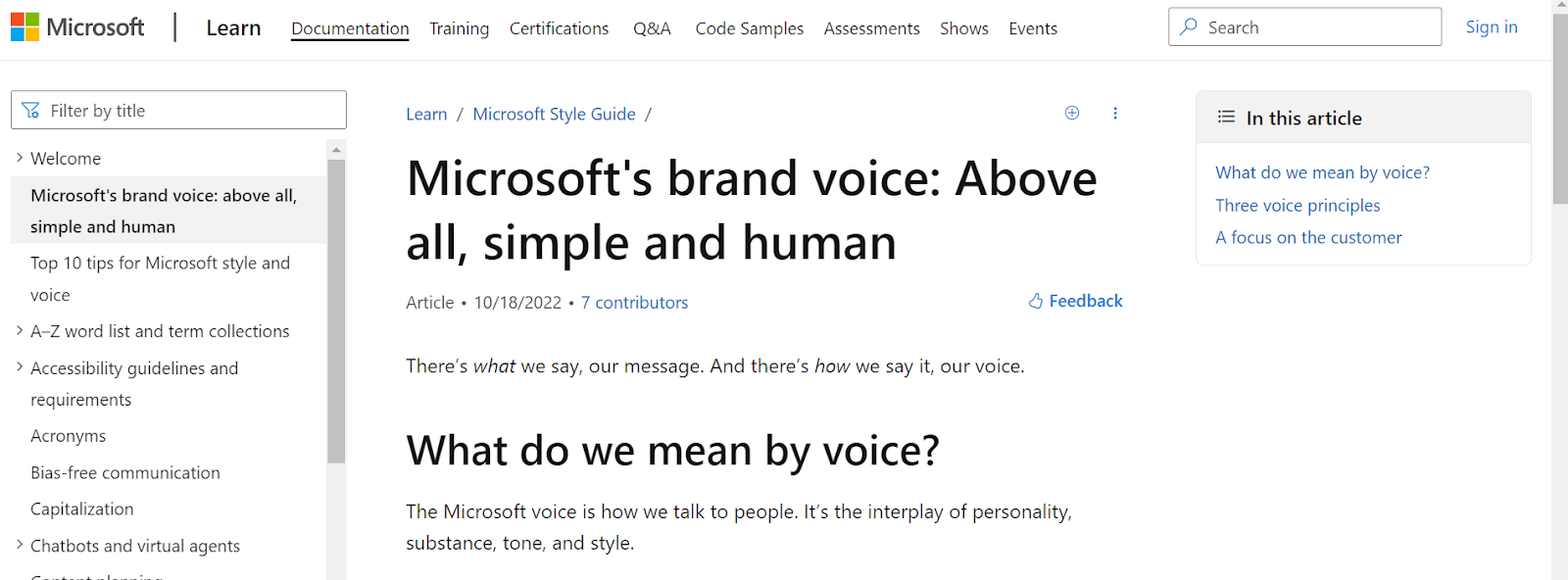
Image Source: Microsoft writing style guide
This style guide contains many examples to help you see what works and what doesn’t with technical writing. The tricky sections, such as those about grammar, include specific examples, which is just the right amount of depth to give technical writers a complete picture of how to communicate effectively with their target audience. Direct comparisons in specific sections like headers and tones make it easy to grasp information.
-
Apple-Style Guide
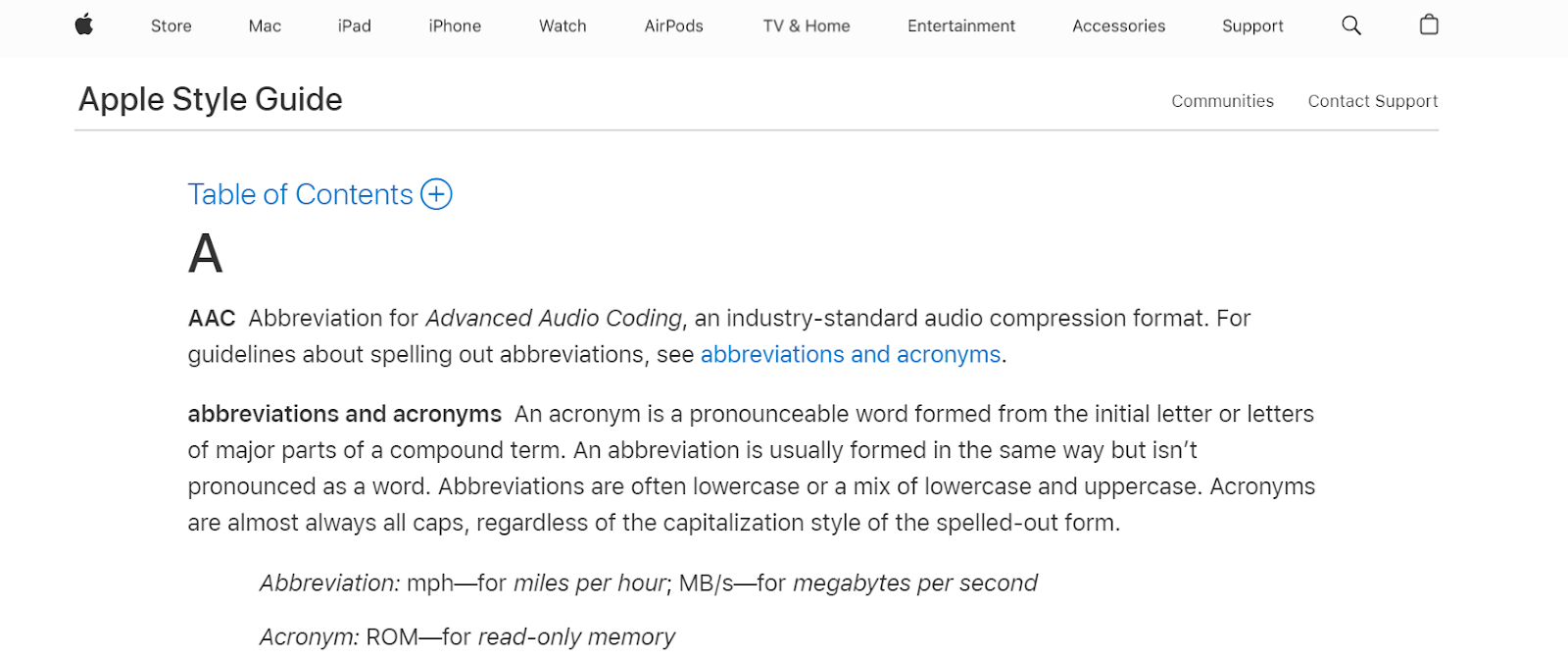
Image Source: Apple style guide
Looking for a streamlined technical style guide that helps technical writers give readers the information they need without overwhelming them with excess? The Apple Style guide uses drop-downs to keep the information as streamlined and straightforward as possible. There are lots of features responsible for the success of this style guide. One of them is the section dedicated to encouraging writers to avoid the use of oppressive words and stereotypes. The guide, which helps technical writers format materials such as training programs and instructional materials, promotes diversity and inclusivity. The updates page is also strategically placed to make it easy for visitors to stay updated on any changes.
-
Mailchimp Content Style Guide
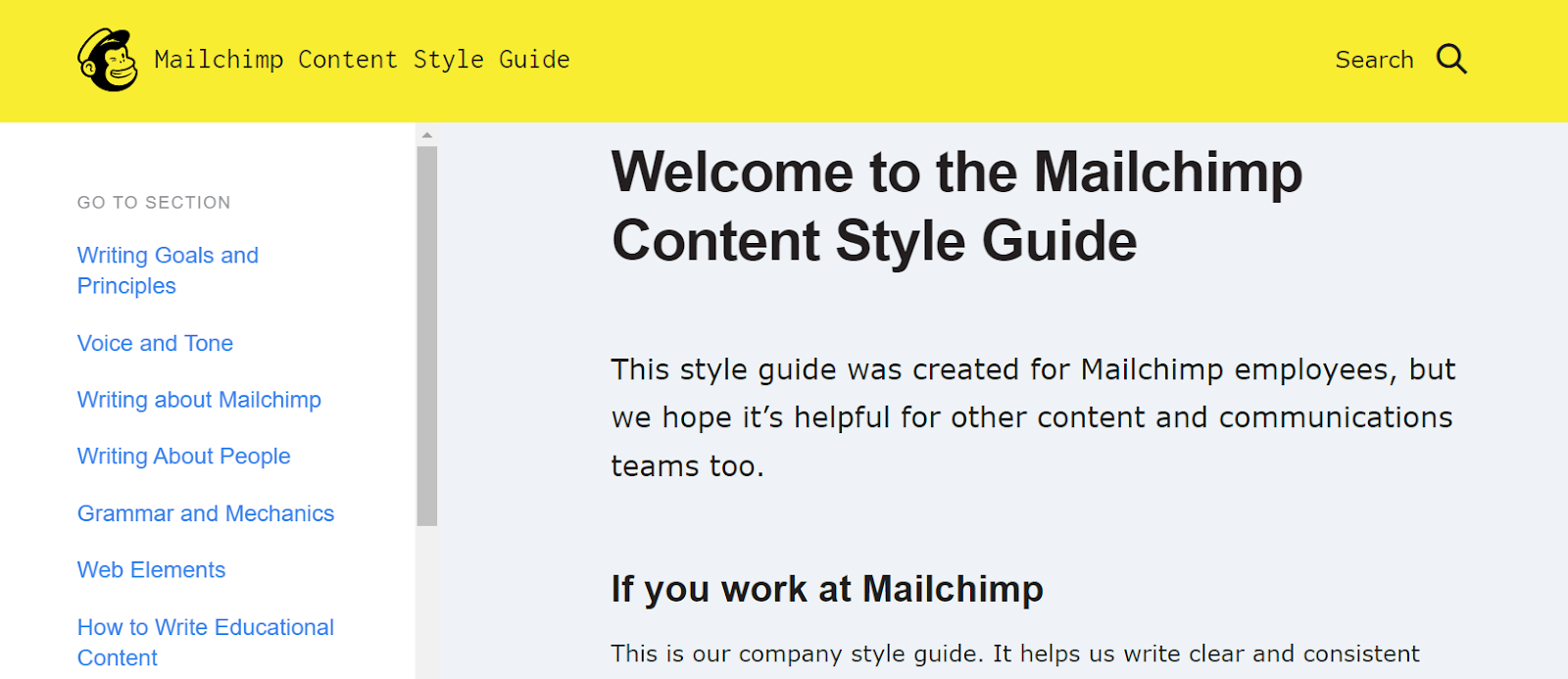
Image Source: Mailchimp style guide
The first thing you would notice about the Mailchimp content style guide is how much of a goldmine it is for specific guidelines on formatting content. This style guide has a section dedicated to guidelines on educational content, as they deal with many materials in this category. Therefore, their policies provide general information on formatting for text and headlines, which non-Mailchimp users can adapt to provide educational resources to their target audience. Some sections cover legal content, formatting for popular social media platforms, and email newsletters.
-
Digital Ocean Technical Writing Guidelines
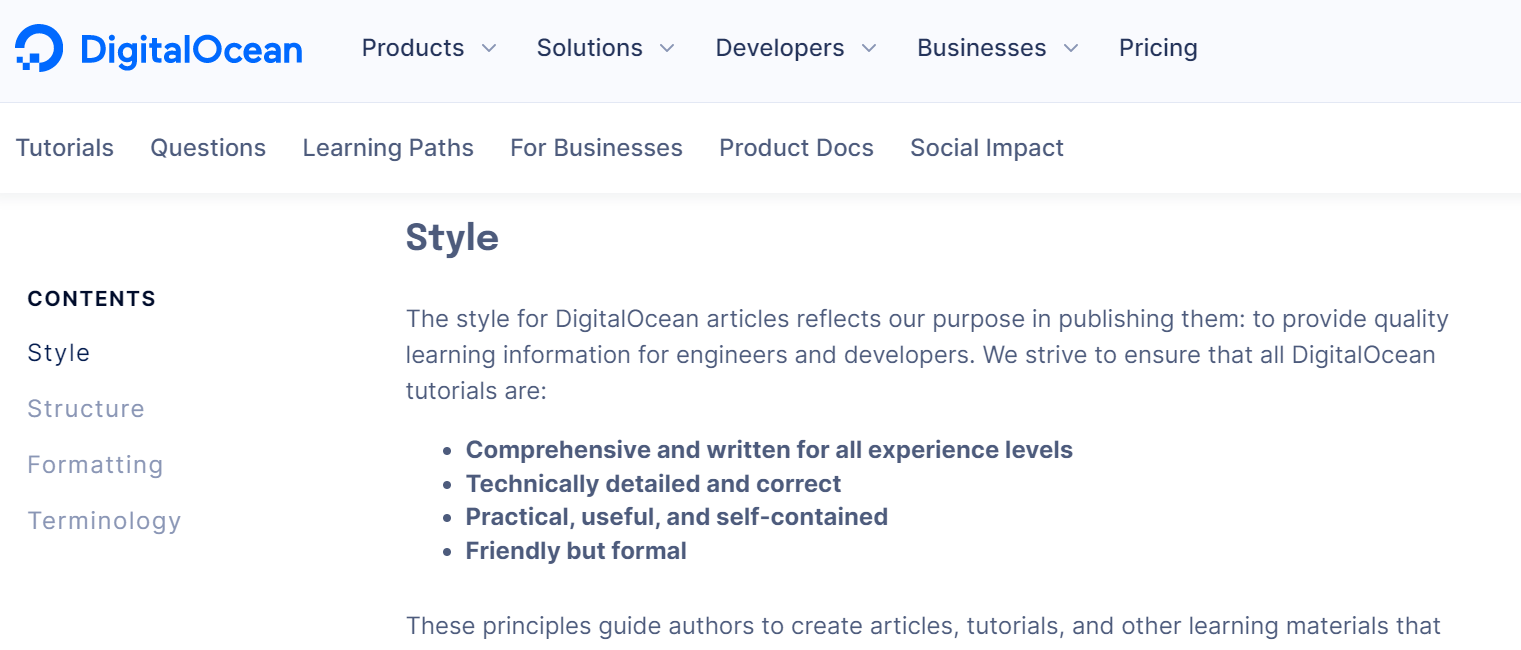
Image Source: Digital Ocean Technical Writing Guidelines
Reading the Digital Ocean technical writing guidelines gives you an instant guide to everything you need to know about writing technical content for this brand. It is a comprehensive technical document covering company-specific terminologies, writing for different experience levels, and providing technically accurate information. Therefore, this single-page guideline covers formatting, structure, and style for writing technical articles such as procedural tutorials.
-
GitLab API style guide
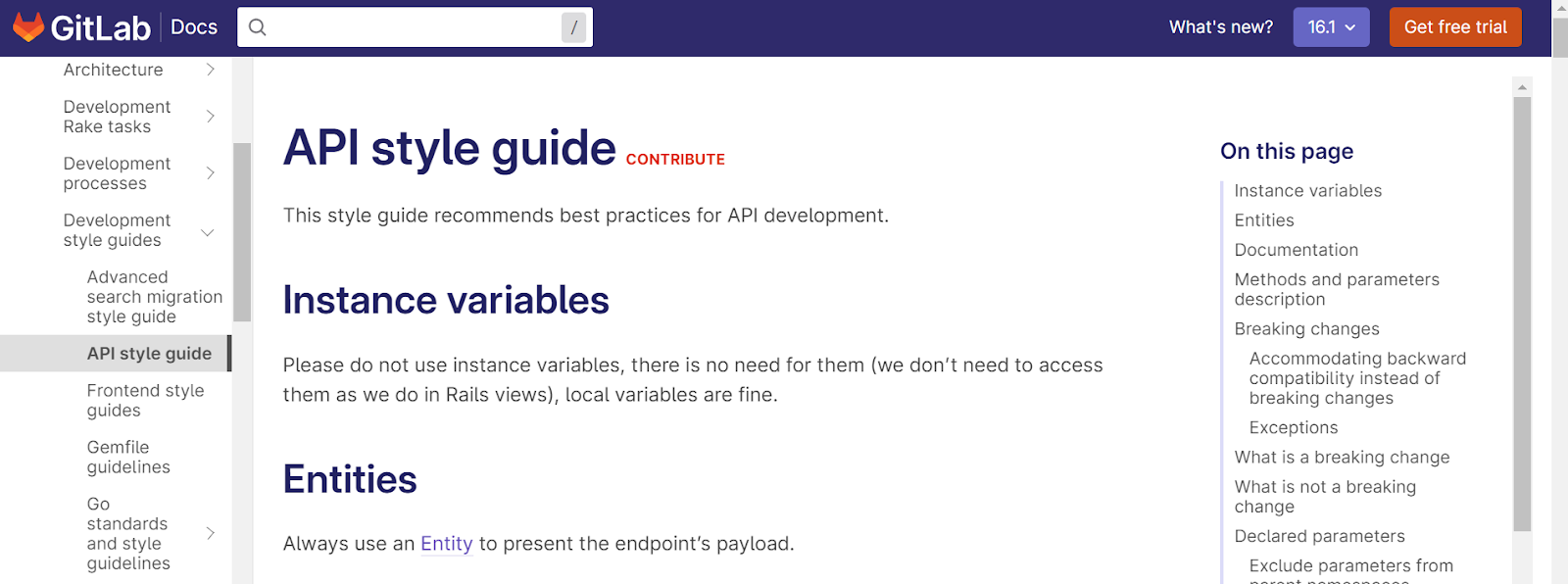
Image Source: Gitlab API style guide
The GitLab team and community use this API style guide, which is constantly updated to incorporate industry changes. It covers writing structure, links, and other formatting guidelines for implementing, troubleshooting, and using the product. A huge plus is the incorporation of the Microsoft and Google style guides which address different aspects of technical document creation for effective communication. The GitLab API style guide defines various rules across various topics, including using active voice for seamless writing presentation.
Interested in Document360 Knowledge base? Schedule a demo with one of our experts
Book A Demo
Also read: Top 11 Tips for Technical Writing
What forms of content can be written Using Technical Writer Style Guides?
Traditional technical documents are written with a technical audience in mind, such as machine repair manuals, owner manuals, developer guides, and maintenance manuals. However, technical writing is a broader concept. Therefore, we can divide technical writing style guides into five categories:
- Technical marketing content: These include catalogs, press releases, advertisements, and promotional brochures. These contents are majorly for brand promotion and communication with their customer base.
- Field service support: Technical documents such as technical and training support guides can be written by using technical writer style guides. These are useful when the writer intends to help technical workers understand maintenance, administration, and software installation procedures.
- End-user documentation: Use style guides for technical documents such as patient information booklets and user manuals to present detailed how-to information.
- Organizational document: Examples of these are sales proposals, marketing proposals, funding proposals, and business plans. This represents a category of technical papers focused on defining deliverables within an organization and helping stakeholders identify the strengths and weaknesses of the process toward achieving their objectives.
- Technical specification documents: Technical documents such as software development and product prototype guides contain technical specifications to provide developmental support to the target audience. Style guides will help you analyze information obtained from experts and present this in easy-to-understand chunks.
Other examples of technical documents include:
- Product knowledge base: Consumers need quick solutions to any issues they encounter while using products. A knowledge base answers their questions in detail and is always available to consumers without the need to contact customer support through a longer process.
- Case studies and whitepapers: Case studies and whitepapers are relevant for organizational research and development. This official document promotes product features and uses cases to help readers understand the product enough to solve possible issues.
- Policy guidelines: Companies require guidelines that contain policies that guide engagement between employees and the company. These rules and regulations can be written by technical writers using a style guide.
- API documentation: API documentation helps developers to use and understand how to integrate APIs into their software applications. Style guides ensure accuracy and clarity while improving the API developer experience.
Also read: Role of Videos in Modern Technical Writing
What Are the Key Benefits of Using Technical Writing Style Guides?
Using the best technical style guide to help you create amazing content comes with many key benefits, including time-saving, consistency, improvements in technical communication, and the spread of easily consumable content.
-
Saves Time
What happens if you don’t put together a proper schedule to help you navigate different tasks for the day? The apparent result is that you won’t have a clear direction and may end up achieving nothing substantial during your working hours. However, when tasks are properly outlined before starting your day, you achieve more within a specific timeframe, similar to what technical writing style guides do for technical writers. Technical writing style guides help you save a lot of time because it contains all the relevant style and formatting guidelines to help you get the best results with minimal effort. This means you can create high-quality documentation within an impressive timeframe. In contrast, the end-users needing this documentation won’t have to spend so much time searching for relevant information. Everyone benefits.
-
Brings Consistency
Suppose your company adopts one of the technical style guide examples discussed earlier in this article. In that case, it becomes valid company-wide, meaning every technical writer within the establishment will use that style. This becomes adopted as the brand’s voice, easily identifiable by end-users since everyone formats documentation similarly.
The advantage of this is consistency, as customers will be willing to interact with your brand across multiple channels when they see that your content is consistent. Consistent brand messaging improves your profile and exudes professionalism, showing you care about communicating clearly with your customers.
-
Improves Technical Communication
Communication is successful when a message is sent to a receiver and correctly interpreted without issues. Miscommunication arises with vague language or a style the receiver needs to become more familiar with. Since technical communication can be internal or external, adopting specific technical writing guidelines that fit your company’s image will leave little to no room for miscommunication.
Therefore, a key benefit of style guides is improving technical communication. For example, internal memos with style guides will contain relevant company terminologies that ensure the memos are interpreted accordingly.
-
It makes the content easily consumable.
No one likes technical content that is neither here nor there. Style guides contain specific formats for grammatical expressions, tone, the use of headings, and so much more which helps technical writers to convey information in friendly chunks for maximum readability. Consumers are likelier to read content from start to finish when it’s presented in a style that’s easy to digest and addresses their pain points with simple language. This makes it easy to skim, as you can scan the document.
Use Document360 to create and maintain a style guide
Document360 provides a flexible and secure content management system that makes creating and maintaining a style guide for technical documentation easy. With this top-notch knowledge base platform, content writers can access state-of-the-art editors to write release notes, how-to guides, and press releases and create a style guide of the SaaS knowledge base.
Also Read: Quick Start Guide: What is it & How do you Create one
Conclusion
The correct technical documentation will help you build a consistent brand voice where your target audience appreciates seamless communication.
Ready to take your technical documentation to the next level with a tool that helps you know and understand your audience? Request a demo on Document360.
An intuitive knowledge base software to easily add your content and integrate it with any application. Give Document360 a try!
GET STARTED




 –
– 

